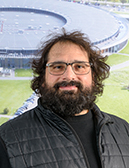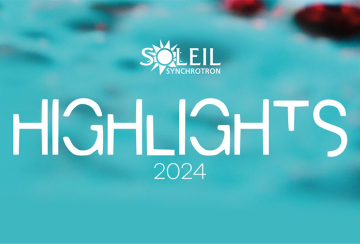
Polarized Light source for Electron and Ion Analysis from Diluted Excited Species : PLEIADES
High resolution soft x-rays for spectroscopy in the diluted phase
PLÉIADES is an ultra high resolution soft X-ray beamline (ultimate resolving power of about 100000 at 50 eV) covering the energy domain ranging from 10 eV to 1 keV. PLÉIADES is dedicated to spectroscopy based atomic and molecular physics studies of diluted samples (atoms, molecules, ions, clusters, molecules adsorbed on surfaces).
All horizontal, vertical and tilted linear polarizations, as well as circular and elliptical polarizations, are available starting from 55 eV thanks to a permanent magnet (80 mm period) Apple II type of undulator. Linear horizontal and vertical polarized beams are available as low as 10 eV from a 2nd (256 mm period) electromagnetic undulator.
In the beamline design, particular care has been taken in order to obtain a very high spectral purity soft X-ray beam : thanks to an appropriate combination of quasi-periodic design for the undulators and the use of a varied groove depth (VGD) for the plane grating, higher orders are very efficiently rejected (usually less than 0.5%).
A high resolution electron spectrometer, an energy and angle Auger electron - ion coincidence setup (EPICEA), as well as a dedicated station (MAIA) for positive and negative ion photoionization studies (ECR source) are permanently installed on the beamline. Moreover, a conventional laser facility (c.w. and pulsed), as well as the possibility of combining high intensity/high repetition rate (1 mJ/100 kHZ, 5 mJ/20 kHZ, 10 mJ/10 kHZ) femtosecond laser pulses from an in-house facility to the synchrotron beam in pump-probe schemes will also be offered to the users in the near future. The beamline has three optical branches with different focusing properties of the beam. Two of them (branch N°2 and N°3) are offering the external users the possibility of installing their own setups (see table below for spot sizes and beam divergences on sample).
Team


Employment
Click here to access to the SOLEIL employment web page
Summary of the PhD Subject linked to the HighEneCh ANR project:
The aim of this thesis is to better understand the physicochemical impact of inner shell ionizations on molecules of biological interest in solution. These extreme events, injecting hundreds of electron volts at the atomic scales, could indeed play a major role in radiobiology.
This thesis will be conducted in the framework of a collaboration between CEA Saclay and the SOLEIL synchrotron and Pierre and Marie Curie University. On the one hand, it will deal with spectroscopic developments to monitor the creation of radical species and the structural changes in ionized biomolecules, and on the other hand to run irradiation experiments, with soft X-rays, on the METROLOGIES and PLEIADES beamlines. An ab-initio molecular dynamics simulation component will also be developed in collaboration with Pierre et Marie Curie University. This thesis is co-financed by the Synchrotron SOLEIL and the National Research Agency, within the framework of the project ANR-17-CE30-0017-HighEneCh.
For additional information contact Christophe Nicolas and download the full subject from the downloads menu
Summary of the SOLVATAXION PhD within the collaboration between Synchrotron SOLEIL and GANIL (Caen):
The aim of the present PhD is to understand at the molecular level the role of the environment on the radiation damage of biomolecular systems. The originality of the proposed PhD work relies on the complementarity between the different planned studies:
- different excitation/ionization sources will be used and the complementarity between X-rays and ions will allow to investigate the fragmentation dynamics over a large excitation range giving a complete map of the decay mechanisms;
- moreover different spectroscopies (photoelectron XPS, absorption NEXAFS) will give information on the structure of the molecular systems studied.
This work is in collaboration between Synchrotron SOLEIL and the CIMAP laboratory located in Caen. Therefore it benefits from the knowledge and know-how of both teams. In addition to experiments performed on existing devices in both laboratories, the candidate will participate in the development of new sources of microsolvated systems with enhanced performances.
This PhD thesis will be co-supervised by Aleksandar Milosavljevic (Synchrotron SOLEIL) and Patrick Rousseau (CIMAP) and will take place in the exciting and demanding environment of large-scale facilities (SOLEIL, GANIL). The PhD is co-funded by Synchrotron SOLEIL and the Normandie region. It is performed in the framework of an international associated laboratory (LIA DYNAMO, CIMAP/Stockholm University/Universidad Autonoma de Madrid) and of an international collaboration program (PICS BIFACE, CIMAP/CNR-ISM in Rome), both projects are funded by CNRS.
For additional information contact Aleksandar Milosavljevic and download the full subject from the downloads menu.
Technical data
10 eV - 1000 eV
15000 (10 eV - 40 eV), 20000 - 100000 (35 eV - 1000 eV)
Electromagnetic HU256 (256 mm period) and Apple II permanent magnet HU80 (80 mm period) undulators
About 1.2·10+15 Photons/s/0.1% BW @ 100 eV
PGM using varied line spacing (VLS) & varied groove depth (VGD) technologies with no entrance slit
Differentially pumped gas cell for high resolution electron spectrometer
Continuous measurement of the beam intensity (I0)
ECR ion source
Gas inlet systems for the electron spectrometer and EPICEA coincidence setup
50(H)x30(V) µm2 on branch N°2 ; 180(H)x100(V) µm2 on branch N°3
9mrad (H) - 4mrad (V) on branch N°2 ; 2mrad (H) - 0.6 mrad (V) on branch N°3
About 1·10+13 Photons/s/0.1% BW
High resolution electron spectrometer, Electron - ion coincidence setup with PSDs
10 - 40 eV (linear H, V); 35 - 1000 eV (linear H, V, tilted, elliptical)
Scientific Opportunities
| Decay dynamics of inner-shell excited molecules and clusters |
|
|---|---|
| Vector correlations and angular distributions in valence-shell and inner-shell photoionization |
|
| Multiple photoionization studies of atoms and molecules |
|
| Photoionization of ions |
|
| Experiments coupling laser and SR beams |
|
| Photochemistry |
|


